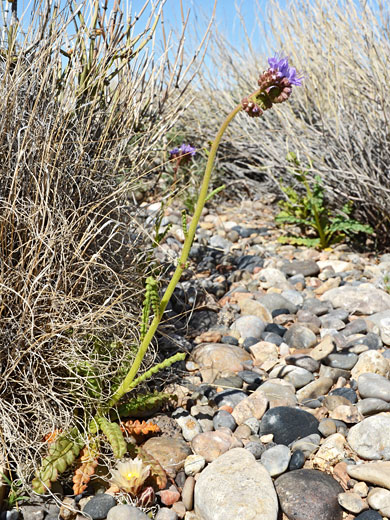Scientific name:
Pediocactus peeblesianus
Common name:
Navajo pincushion cactus
Range:
Northwest Arizona
Form:
Small globes, solitary or few-branched
Habitat:
Grassland and desert scrub, on gravelly, alkaline soils, from 4,000 to 5,500 feet
Flowers:
Pale yellow or greenish yellow, blooming in the spring

Distribution map for pediocactus peeblesianus
Pediocactus peeblesianus is a rare but easily-identified species, found only in northern Arizona, in a broad band from the vicinity of Holbrook, northwestwards to the Shivwits Plateau. The unusual feature are the white or pale gray spines, which are corky in texture - soft, though more rigid at the tips, thick, twisted, and irregularly arranged. There are between three and seven radial spines per areole, up to a third of an inch in length, and sometimes one central spine. There may also be one upwards-pointing intermediate spine, up to 0.8 inches. Stems are spherical or slightly-egg shaped, at most 2 inches across.
Flowers, up to 1 inch in diameter, have purplish-brown midstripes on the outer tepals, and are otherwise pale yellow, or slightly greenish-yellow. Stamens and stigma lobes are also yellow.
There are two subspecies of pediocactus peeblesianus; most plants are ssp fickeiseniae, with six or seven radial spines, and usually one central spine. The other, ssp peeblesianus, has four (occasionally three or five) radial spines, and never a central spine; this is found towards the southeast section of the range.
Flowers, up to 1 inch in diameter, have purplish-brown midstripes on the outer tepals, and are otherwise pale yellow, or slightly greenish-yellow. Stamens and stigma lobes are also yellow.
There are two subspecies of pediocactus peeblesianus; most plants are ssp fickeiseniae, with six or seven radial spines, and usually one central spine. The other, ssp peeblesianus, has four (occasionally three or five) radial spines, and never a central spine; this is found towards the southeast section of the range.
All Contents © Copyright The American Southwest | Comments and Questions | Contribute | Affiliate Marketing Disclosure | Site Map


